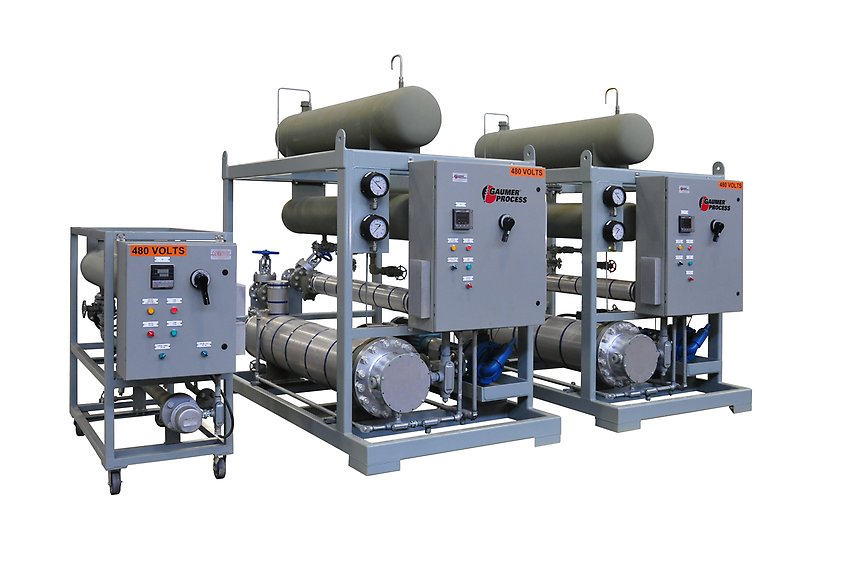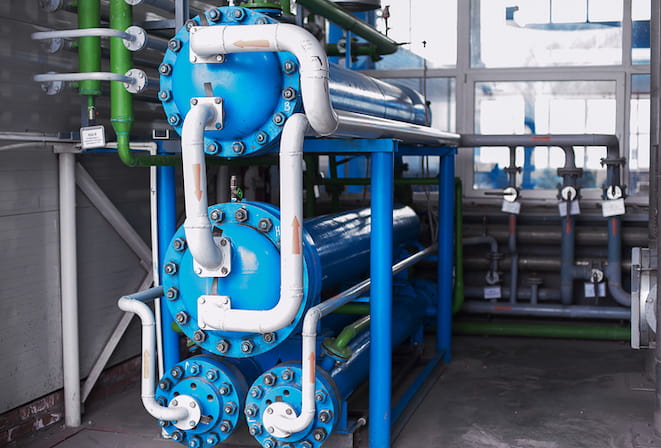Why Are DVS Heat Transfer Systems Ideal for Aerospace Thermal Solutions?
Wiki Article
Discovering the Conveniences and Applications of Heat Transfer Equipments in Modern Sector
Heat transfer systems play a vital function in modern-day market. They incorporate different devices such as conduction, radiation, and convection, each adding to effective thermal monitoring. Industries like manufacturing and aerospace benefit greatly from these systems. As advancements proceed, the integration of cutting-edge products and technologies assures to improve energy efficiency. This evolution increases essential questions regarding the future effects for sustainability and functional prices throughout multiple fields. What exists ahead in this recurring makeover?Recognizing Heat Transfer Concepts
Heat transfer concepts are essential to the procedure of various commercial systems. These principles incorporate the mechanisms of convection, transmission, and radiation, each playing a crucial duty in taking care of thermal energy. Comprehending conduction includes analyzing exactly how Heat moves with strong materials, while convection refer to Heat transfer in fluids, driven by fluid movement. Radiation, distinct from the other 2, involves power transfer with electro-magnetic waves. The efficiency of Heat transfer effects system efficiency, power intake, and general efficiency. Effective thermal administration is essential in processes such as heating, Heat, and cooling recovery. By grasping these concepts, sectors can maximize their operations, lower power prices, and enhance devices durability, therefore contributing to a more lasting and efficient commercial landscape.Trick Kinds of Heat Transfer Solutions
While different markets use Heat transfer systems for diverse applications, several key kinds stand apart due to their specific functions and efficiencies. The most typical kinds consist of radiation, convection, and conduction systems. Transmission systems transfer Heat with direct contact in between products, making them efficient in solid-state applications. Convection systems, on the various other hand, make use of fluid motion to transfer Heat, appropriate for heating or cooling down gases and fluids. Radiation systems run without a tool, relying upon electromagnetic waves to move Heat, perfect for high-temperature atmospheres. Each kind offers unique purposes, permitting industries to customize their Heat transfer remedies based on functional requirements, energy efficiency, and cost-effectiveness. Comprehending these systems is vital for enhancing performance in numerous commercial settings.Industrial Applications of Heat Transfer Technologies
The application of Heat transfer technologies in sector plays an important role in boosting energy efficiency and maximizing processes. DVS Heat Transfer Systems. By implementing innovative Heat exchange systems, companies can greatly lower their ecological impact while boosting overall performance. This combination not only fosters sustainability yet likewise aligns with modern governing and consumer needs for greener practicesPower Effectiveness Improvements
As industries progressively prioritize sustainability, power efficiency enhancements in Heat transfer innovations have actually ended up being important for reducing operational costs and environmental influence. Improved Heat exchangers, for circumstances, make use of sophisticated products and layouts to make the most of thermal efficiency while reducing power intake. Furthermore, incorporating variable rate drives in pumping systems enables much better control of fluid flow, resulting in substantial power savings. The implementation of wise sensors and automation supplies real-time surveillance, making it possible for changes that enhance power usage. Additionally, waste Heat recovery systems capture excess thermal energy, converting it into usable power. These developments not only enhance energy effectiveness however likewise contribute to an extra lasting commercial landscape by lowering greenhouse gas exhausts and sustaining compliance with environmental policies.Process Optimization Techniques
Process optimization methods are important in boosting the effectiveness and efficiency of Heat transfer technologies in commercial applications. These strategies include refining processes to make the most of Heat transfer efficiency while decreasing energy consumption and functional prices. Approaches such as computational liquid characteristics (CFD) modeling permit designers to imitate and examine Heat transfer circumstances, identifying areas for renovation. Furthermore, real-time monitoring systems can provide beneficial data on temperature level slopes and flow prices, making it possible for modifications that maximize performance. Furthermore, implementing sophisticated control techniques, such as anticipating analytics, can boost system responsiveness to varying functional demands. By applying these optimization strategies, industries can attain higher thermal efficiency, minimized downtime, and improved product top quality, ultimately bring about enhanced competition in the industry.
Ecological Influence Decrease
While industrial Heat transfer technologies are necessary for operational efficiency, their application additionally presents opportunities for considerable ecological impact reduction. By boosting power performance, these systems minimize fuel usage, bring about reduced greenhouse gas emissions. Progressed Heat exchangers can recuperate waste Heat, rerouting it to preheat inbound liquids, therefore reducing energy needs. In addition, the integration of Heat transfer technologies in renewable resource systems, such as solar thermal and geothermal applications, supports the change to lasting techniques. Industries that use these technologies additionally profit from lowered functional prices and boosted governing conformity. On the whole, the critical execution of Heat transfer systems not only bolsters productivity yet additionally cultivates an extra sustainable industrial landscape, adding to worldwide environmental objectives.Benefits of Effective Heat Transfer Equipments
Effective Heat transfer systems use substantial advantages in modern sector, mostly with enhanced energy performance and price reduction. By enhancing thermal administration, these systems minimize power waste, bring about lower operational expenses (DVS Heat Transfer Systems). Services can achieve better sustainability and improved productivity.
Energy Efficiency Improvements
As industries significantly focus on sustainability and cost-effectiveness, energy effectiveness enhancements in Heat transfer systems have actually become a vital focus. Boosted effectiveness in these systems leads to lowered energy consumption, enabling centers to operate even more sustainably. By enhancing Heat transfer techniques, industries can reduce waste Heat and attain much better thermal management, considerably lowering their ecological impact. Breakthroughs in innovations such as Heat exchangers and insulation materials add to improved efficiency and reliability. In addition, executing energy-efficient Heat transfer solutions not just sustains compliance with regulative DVS Heat Transfer Systems standards however also promotes a society of development within companies. Eventually, these renovations are important in aligning industrial operations with international power conservation goals, leading the way for a much more lasting future in production and handling sectors.Cost Reduction Opportunities
By enhancing Heat transfer systems, markets can expose considerable expense decrease possibilities that boost their lower line. Reliable Heat transfer lowers power intake, causing lower utility expenses and lessening functional costs. Furthermore, improved system performance reduces the requirement for maintenance and fixings, in addition conserving prices with time. Boosted Heat transfer can likewise prolong equipment lifespan, permitting companies to postpone capital investment on replacements. In addition, waste Heat recuperation systems can transform excess Heat right into useful energy, even more driving down prices. These systems not only simplify procedures but additionally add to sustainability initiatives, placing business favorably in a progressively eco-conscious market. In general, the financial advantages of efficient Heat transfer systems are essential and significant for competitive benefit.Advancements in Heat Transfer Solutions
Exactly how can modern sector enhance its operations with innovative Heat transfer services? By taking on sophisticated materials and innovations, markets can greatly boost thermal efficiency and efficiency. Developments such as nanofluids, which boost Heat transfer capacities beyond traditional liquids, and phase adjustment materials that save and release thermal power, are acquiring grip. Additionally, the combination of clever sensors and IoT gadgets permits for real-time monitoring and optimization of Heat transfer procedures, reducing waste and enhancing system responsiveness. Additive production techniques enable the development of even more intricate Heat exchangers that maximize surface area while reducing material usage. Collectively, these advancements drive functional efficiency and create competitive advantages in various fields, consisting of aerospace, power, and production.The Duty of Heat Transfer in Sustainability Initiatives
While the promote sustainability remains to reshape industries, the role of Heat transfer technologies comes to be significantly essential in achieving ecological objectives. Efficient Heat transfer systems facilitate energy performance by maximizing thermal administration in various procedures, considerably decreasing energy usage and greenhouse gas exhausts. As an example, progressed Heat exchangers are made use of in commercial applications to recover waste Heat, consequently reducing power waste. Furthermore, developments such as phase adjustment products boost thermal storage space, adding to renewable resource integration. The fostering of sustainable fluids in Heat transfer systems can decrease ecological impact. By focusing on efficient Heat transfer, industries not just improve functional performance however additionally line up with international sustainability initiatives, cultivating a cleaner, much more lasting future.Frequently Asked Concerns
How Do Heat Transfer Equipments Impact Energy Prices in Manufacturing?
Heat transfer systems considerably affect power costs in production by boosting efficiency, reducing waste, and optimizing thermal management. These renovations lead to decrease operational expenses, ultimately profiting general performance and earnings in commercial procedures.What Maintenance Is Required for Heat Transfer Solutions?
Upkeep for Heat transfer systems consists of normal inspections, cleansing of components, checking fluid levels and conditions, replacing worn components, and making sure correct insulation. These activities boost effectiveness, prolong life-span, and protect against pricey breakdowns in operation.Are There Safety Issues With Heat Transfer Systems?
Security problems with Heat transfer systems consist of prospective leaks, stress accumulation, and thermal dangers. Proper layout, routine maintenance, and adherence to safety and security procedures are vital to mitigate these dangers and guarantee risk-free procedure in industrial settings.
Exactly How Can I Pick the Right Heat Transfer System for My Company?
Picking the best Heat transfer system entails assessing variables such as effectiveness, application needs, budget restrictions, and safety and security standards. A detailed analysis of these aspects will certainly help ensure excellent performance and dependability in organization operations.What Prevail Failings in Heat Transfer Solutions and Their Reasons?

Understanding conduction involves analyzing how Heat moves via strong materials, while convection pertains to Heat transfer in fluids, driven by fluid activity. By maximizing Heat transfer approaches, industries can reduce waste Heat and attain far better thermal management, considerably decreasing their ecological influence. Waste Heat recovery systems can transform excess Heat into usable energy, additionally driving down expenses. Progressed Heat exchangers are made use of in commercial applications to redeem waste Heat, therefore minimizing energy waste. Usual failings in Heat transfer systems consist of leakages, deterioration, and ineffective Heat exchange.
Report this wiki page